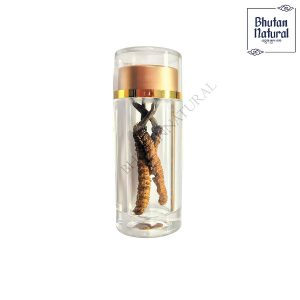Bhutan Wild Premium Cordyceps (Bulk Purchase)
Bhutan Wild Premium Cordyceps (Bulk Purchase)
SGD1,544.50
Bhutan Cordyceps (Yartsa Goenbub) is an annual harvest that matures between May to July of the year.
Every year, in late June, licensed Bhutanese farmers will ascend the sacred mountains in the regions of Paro, Wangduephodrang, Gasa, Lhuntse, Trashigang, Trashiyangtse, and Bumthang in search of Cordyceps.
Environmental condition determines the quality of the Cordyceps. Bhutan’s best wild Cordyceps are produced in naturally cold environments, in Khangdang of Bumthang above 3500m and Shingchenla of Laya above 5010m.
Bhutan Cordyceps (Yartsa Goenbub) is an annual harvest that matures between May to July of the year.
Every year, in late June, licensed Bhutanese farmers will ascend the sacred mountains in the regions of Paro, Wangduephodrang, Gasa, Lhuntse, Trashigang, Trashiyangtse, and Bumthang in search of Cordyceps.
Harvesting is extremely difficult because of its remoteness near the border of the Tibetan Autonomous Region of China and negative temperature.
WHY BHUTAN WILD CORDYCEPS
Environmental condition determines the quality of the Cordyceps. Bhutan’s best wild Cordyceps are produced in naturally cold environments, in Khangdang of Bumthang above 3500m and Shingchenla of Laya above 5010m.
TRADITIONAL CHINESE MEDICINE & AYURVEDA INTEGRATIVE MEDICINE BENEFITS:
- Lessens fatigue and energy booster
- Powerful immune booster
- Improves respiratory function in general
- Enhances athletic performance
Other benefits:
Malignant Tumor, Liver Disease, Kidney Diseases, Low Blood Pressure, and Dizziness. Bronchitis, Cough and Cold, Arthritis, Jaundice, Prostate Enlargement, Chronic Pain, Sciatica and Backache, and Diabetics. Rheumatism, Coronary Heart Disease, and Alcoholic Hepatitis
SELECTING GOOD WILD CORDYCEPS
Cordyceps are usually graded according to the thickness of the larva body. According to the Department of Pharmacology, Sikkim Manipal Institutes of Medical Science, concludes that the more intense the eyes of the cordyceps are, the higher the active ingredient, the better the effect.
The body section should be plump, yellowish, complete with eight pairs of legs, while the fungi section should be intact.
DIFFERENCE BETWEEN BHUTAN WILD CORDYCEPS AND TIBETAN CORDYCEPS

The critical difference between the Bhutan Wild Cordyceps and the Tibetan Cordyceps are the colour of the eyes; red colour eyes mean higher the adenosine level, and black colour eyes mean lower adenosine level found in the Cordyceps.
CORDYCEPS BENEFITS IN CANCER: (CHINESE HERBAL COOKING – YOUR COMPANION DURING CANCER – TTSH COMPLEMENTARY INTEGRATIVE MEDICINE CLINIC) ADENOSINE PHARMACOLOGICAL EFFECTS
Cordyceps has possible anti-cancer properties. Researchers at the University of Nottingham found that cordycepin, a compound extracted from Cordyceps, effectively stopped the growth of several types of cancers.
At low doses, Cordycepin interfered with the production of proteins required for cell multiplication and tumour growth. At higher doses, Cordycepin directly induced cell death.
SCIENTIFIC RESEARCH:
A scientific report published on 22nd of November 2016 by the State Key Laboratory of Quality Research in Chinese Medicine, the Institute of Chinese Medical Sciences, and the University of Macau – “Cordyceps collected from Bhutan, an appropriate alternative of Cordyceps sinensis.”
Identification of Bhutanese Cordyceps via morphological characteristics of Bhutanese Cordyceps compared to Natural Cordyceps Sinesis were similar, but the distinct difference lies in their eyes
According to GenBank NCBI nucleotide database, ITS sequence of Bhutanese Cordyceps was 99% homologous to that of C. sinensis. Confirming the fungus in Bhutanese Cordyceps as C. sinensis.
The mitochondrial results of the COI and Cytb sequences in host insect of Bhutanese Cordyceps suggested that species of host insect of Bhutanese Cordyceps belonged to Hepialidae sp, which was per those of Cordyceps Sinensis.
HOW TO EAT BHUTAN WILD CORDYCEPS THE RIGHT WAY
1. BOIL CORDYCEPS WITH WATER

Pour boiling water into a pot of Cordyceps sinensis (1-3 pieces)
Slimer it for 10 minutes on low heat
Pour and consume it immediately (Color of the extract will be light brownish color)
Add water and simmer for another 10 minutes in low heat
Repeat all the processes until the color of the extract no longer remains light brownish in color)
Lastly, consume the Cordyceps directly
2. STEW WITH MEAT (SOUP BASED) –

Cordyceps and stew are the best to eat together, but be aware that Cordyceps cannot be stewed too long, as nutrients can be easily lost through prolonging boiling.
1) Steamed Chicken with Cordyceps: 4 servings
300g chicken thighs, 15g cordyceps, 2 pieces dried tangerine peel, 15g dried red dates, shredded ginger, spring onion, sesame oil, 2 tsp chinese rice wine, 1/2 tsp salt, 2 tsp sugar, 2 tsp soy sauce, 2 tsp corn flour
2) Lean Pork Soup with Cordyceps: 6 servings
500g lean pork, 15g cordyceps, 15g wolf berries, 15g red dates, 15g pseudostellaria root, and 1/2 tsp salt.
3) Egg with Cordyceps and Rock Sugar: 2 servings
2 medium eggs, 3g cordyceps, and 30g rock sugar
REFERENCE:
Wu, D.-T. et al. Cordyceps collected from Bhutan, an appropriate alternative of Cordyceps sinensis. Sci. Rep. 6, 37668; DOI: 10.1038/srep37668 (2016).
Traditional Uses and Medicinal Potential of Cordyceps Sinensis of Sikkim. Ayurveda Regional Research Institute,1Department of Pharmacology, Sikkim Manipal Institutes of Medical Sciences, Gangtok, Sikkim, India
Additional information
| Weight | N/A |
|---|---|
| Grade | A, B, C, D |
| Pieces | 100 |






Reviews
There are no reviews yet.